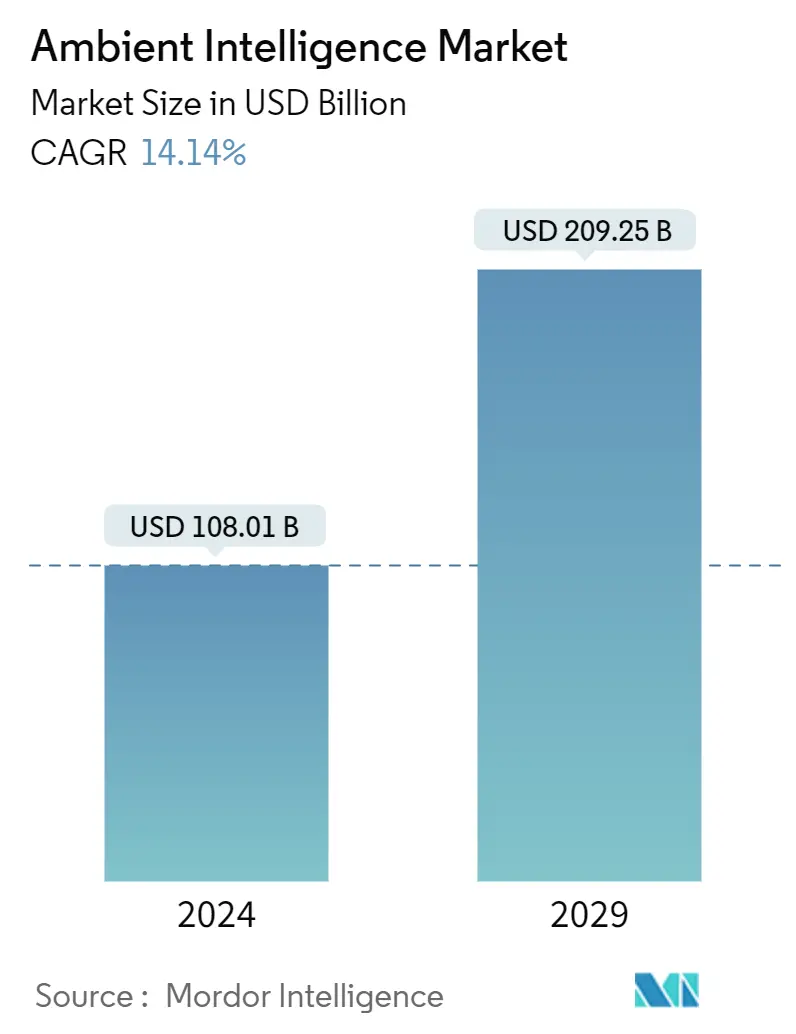Market Size of Ambient Intelligence Industry

| Study Period | 2019 - 2029 |
| Market Size (2024) | USD 108.01 Billion |
| Market Size (2029) | USD 209.25 Billion |
| CAGR (2024 - 2029) | 14.14 % |
| Fastest Growing Market | Asia-Pacific |
| Largest Market | North America |
| Market Concentration | Low |
Major Players
*Disclaimer: Major Players sorted in no particular order |
Ambient Intelligence Market Analysis
The Ambient Intelligence Market size is estimated at USD 108.01 billion in 2024, and is expected to reach USD 209.25 billion by 2029, growing at a CAGR of 14.14% during the forecast period (2024-2029).
Ambient intelligence is an emerging multidisciplinary setup environment wherein the solution operates at the nexus of numerous technologies, such as advanced sensor networks, big data, artificial intelligence, pervasive-ubiquitous computing, and human-computer interaction (HCI).
- Ambient intelligence built on ambient computing artificial intelligence (AI) and machine learning (ML) technologies demands a high-performance, efficient architecture that can scale to support devices everywhere to comprehend and anticipate human needs in their surroundings and respond autonomously.
- The increased adoption of smart homes and buildings is one of the main drivers of the market's growth, as smart homes and buildings use ambient intelligence technology to optimize energy consumption, resulting in energy savings and a significant reduction of carbon footprint.
- Using a variety of IoT sensors and devices, ambient intelligence uses intelligent digital systems deployed in homes or workplaces to perceive the surroundings and user context. The Ambient intelligence system then processes the data gathered from these systems.
- The ambient intelligence system analyzes data to determine user proximity, state, intent, and behavior after it has been processed and analyzed. Then, it makes an intuitive decision using insights from the available data, past knowledge, and pattern recognition. Subsequently, it determines the optimal course of action and provides feedback to the user via a natively built, user-friendly smart device interface.
- Businesses and individuals can benefit from ambient intelligence in several ways. Individually, ambient intelligence can make life easier and more comfortable at home by automating routine functions like temperature control and lighting. Ambient intelligence can benefit organizations in many ways, including better customer experiences through customization options, automated procedures that increase efficiency, and enhanced security measures that safeguard occupant safety.
- The development of advanced sensors is expected to fuel the market’s growth, as these sensors enable real-time monitoring of the environment. Also, the increase in investment in IoT and smart city infrastructure by the government and businesses are driving market growth.
- However, as these systems collect and analyze sensitive data, the higher implementation cost and the concern about privacy and security restrain the market growth. Also, the limited awareness of the technology and its benefits limits the market’s growth.
- The emergence of the COVID-19 pandemic had a mixed impact on the market as some sectors accelerated the adoption of ambient intelligence technology while others slowed down the market’s growth. The increased demand for remote monitoring and automation in industries like healthcare, manufacturing, and logistics positively impacted market growth.
Ambient Intelligence Industry Segmentation
The ambient intelligence (AmI) concept was introduced by the European Commission's Information Society Technologies Advisory Group (ISTAG), which refers to a digital environment that proactively and sensibly supports users in their daily routines. The concept of AmI provides a vision of the information society, emphasizing greater user-friendliness, more efficient service support, user empowerment, and support for human interactions.
The ambient intelligence market is segmented by component (hardware and software & solutions), technology (Bluetooth low energy, RFID, sensors ambient light sensor, software agents, affective computing, nanotechnology, biometrics, and other technologies), end-user industry (residential, retail, healthcare, industrial, office building, automotive and other end-user industries), geography (North America, Europe, Asia-Pacific, Latin America, Middle East and Africa). The market sizes and forecasts are provided in terms of value (USD) for all the above segments.
| By Component | |
| Hardware | |
| Software and Solutions |
| By Technology | |
| Bluetooth Low Energy | |
| RFID | |
| Sensors Ambient Light Sensor | |
| Software Agents | |
| Affective Computing | |
| Nanotechnology | |
| Biometrics | |
| Other Technologies |
| By End-user Industry | |
| Residential | |
| Retail | |
| Healthcare | |
| Industrial | |
| Office Building | |
| Automotive | |
| Other End-user Industries |
| By Geography | |
| North America | |
| Europe | |
| Asia-Pacific | |
| Latin America | |
| Middle East & Africa |
Ambient Intelligence Market Size Summary
The ambient intelligence market is poised for significant growth, driven by the integration of advanced technologies such as artificial intelligence, machine learning, and IoT sensors. This multidisciplinary environment enhances user experiences by automating and optimizing interactions in smart homes and buildings, thereby improving energy efficiency and reducing carbon footprints. The market's expansion is further supported by the increasing adoption of smart city infrastructure and the development of advanced sensors for real-time environmental monitoring. However, challenges such as high implementation costs, privacy concerns, and limited awareness of the technology's benefits may hinder market growth. The COVID-19 pandemic has had a mixed impact, accelerating adoption in sectors like healthcare and logistics while slowing down in others.
In the healthcare sector, ambient intelligence is transforming patient care by enabling remote health monitoring and improving operational efficiencies. Technologies like Ambient Assisted Living (AAL) are particularly beneficial for elderly care, enhancing independent living and patient outcomes. The market is witnessing collaborations and innovations, such as 3M Health Information Systems partnering with Amazon Web Services to advance ambient clinical documentation. North America is expected to hold a significant market share due to its early adoption of advanced technologies and the presence of key players. The demand for smart buildings, driven by safety, security, and energy efficiency concerns, is also contributing to market growth. Major players in the market are focusing on product development, global expansion, and strategic partnerships to enhance their offerings and capture a larger market share.
Ambient Intelligence Market Size - Table of Contents
-
1. MARKET INSIGHTS
-
1.1 Market Overview
-
1.2 Industry Attractiveness - Porter's Five Forces Analysis
-
1.2.1 Bargaining Power of Suppliers
-
1.2.2 Bargaining Power of Consumers
-
1.2.3 Threat of New Entrants
-
1.2.4 Threat of Substitute Products and Services
-
1.2.5 Intensity of Competitive Rivalry
-
-
1.3 Industry Value Chain Analysis
-
1.4 Product Life Cycle Analysis
-
1.5 Customer Acceptance/Adaptability
-
1.6 Comparative Analysis
-
1.7 Investment Scenario
-
1.8 Assessment of the Impact of COVID-19 on the Market
-
-
2. MARKET SEGMENTATION
-
2.1 By Component
-
2.1.1 Hardware
-
2.1.2 Software and Solutions
-
-
2.2 By Technology
-
2.2.1 Bluetooth Low Energy
-
2.2.2 RFID
-
2.2.3 Sensors Ambient Light Sensor
-
2.2.4 Software Agents
-
2.2.5 Affective Computing
-
2.2.6 Nanotechnology
-
2.2.7 Biometrics
-
2.2.8 Other Technologies
-
-
2.3 By End-user Industry
-
2.3.1 Residential
-
2.3.2 Retail
-
2.3.3 Healthcare
-
2.3.4 Industrial
-
2.3.5 Office Building
-
2.3.6 Automotive
-
2.3.7 Other End-user Industries
-
-
2.4 By Geography
-
2.4.1 North America
-
2.4.2 Europe
-
2.4.3 Asia-Pacific
-
2.4.4 Latin America
-
2.4.5 Middle East & Africa
-
-
Ambient Intelligence Market Size FAQs
How big is the Ambient Intelligence Market?
The Ambient Intelligence Market size is expected to reach USD 108.01 billion in 2024 and grow at a CAGR of 14.14% to reach USD 209.25 billion by 2029.
What is the current Ambient Intelligence Market size?
In 2024, the Ambient Intelligence Market size is expected to reach USD 108.01 billion.

